
Incredible First Hand Photographs of the Ukraine Conflict by Photographer Mark Estabrook

Mark Estabrook is a commercial airline pilot and street photographer who traveled to Kiev in February 2014 and was hit by grenades while photographing. He formerly served as an AWACS Aircraft Commander in the Persian Gulf and in the North Atlantic during the 1980s. He is working on a book about his experience in Kiev. All images © 2014 Mark Estabrook, do not re-use without prior permission.
Sometimes we see or hear something that causes our blood pressure to go up ever so slightly. For me it was a TV broadcast with the simple phrase: “Ukrainian police are trying to put down a terrorist uprising in Kiev.” This reporting had Vladimir Putin’s fingerprints all over it and I flew to Kiev to find out. I secured a press pass from a professional photography group I belong to and my jumpseat privileges as an airline pilot got me to Cologne, Germany. From Cologne I purchased a commercial round trip passenger ticket to Kiev.
Upon my arrival in Kiev on February 5, 2014, I took several days to walk around Maidan, or Independence Square, before I began shooting photos. A professional journalist at the EuroMaidan press office briefed me that I should avoid shooting everyday, never take the same routes to and from Maidan, don’t eat at the same restaurants and try to blend in as much as possible. I tried to follow his suggestions, but his rules were difficult if you wanted to practice photojournalism.
Even with my previous experience in photojournalism and military service in the Air Force that included surveillance work in the Persian Gulf, I was not prepared for a murderous police force that had already kidnapped, tortured, or beaten over 100 journalists in the previous two years. In one incident, a journalist had been decapitated in September 2000, while others have been abducted and are still missing. I was also not prepared to see the Ukrainian fighters challenge armed Berkut police with clubs, rocks and Molotov cocktails.
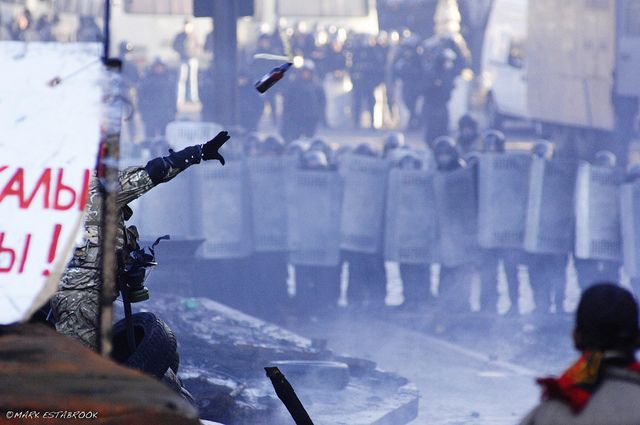
My original thought was to shoot as many portraits of the Ukrainian people in Maidan and perhaps create a “coffee table” art book. I wanted to be able to show Americans through photography that Ukrainian freedom fighters were regular people just like us. Yes, EuroMaidan is formed from a variety of coalitions that includes a nationalist group who wants to expel all Russian people from Ukraine. But it is a difficult time, and to build an instant army of protestors on short notice required putting aside their political differences and fighting together. And fight they did. They may not have money, but they have heart, soul and dreams.
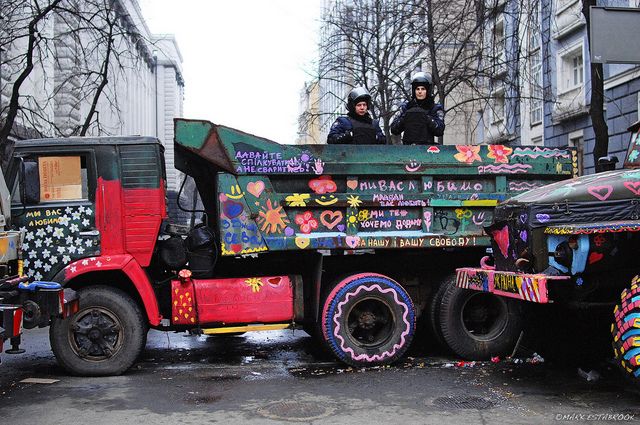
One thing they did not have was the “right to keep and bear arms.” In other words, they were virtually defenseless. It was apparent to me upon my first visit to Maidan that there were piles of rocks and collections of bottles at the ready. It did not take long for me to figure out why. Nevertheless, it was clearthat no Western power was supplying arms to help defend them.
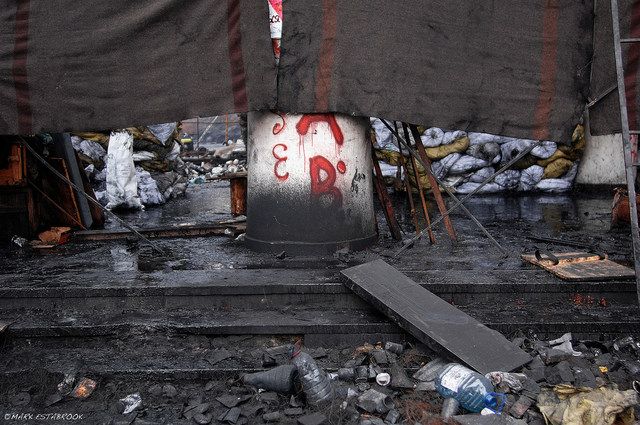
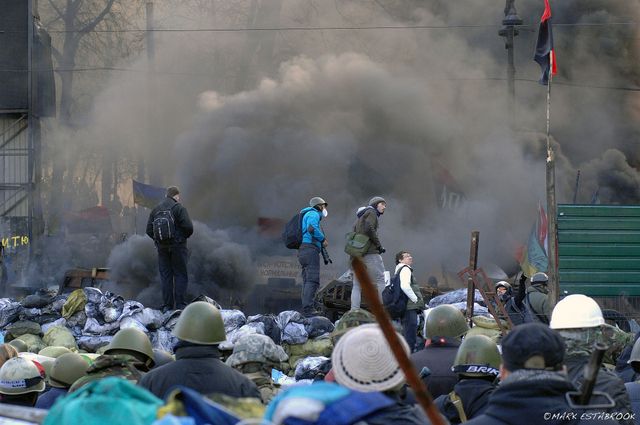
During my stay in Kiev, I even tried to reach out to the Berkut police, and photographed them in a line guarding the Ukrainian president’s official residence in Kiev. One of them cracked a joke about me, and I moved down to get a portrait of him as the others were laughing. “Do you know what happens to funny boys in class?” I asked him. The other policemen laughed again. Some had obviously understood some of my English. “They get their picture taken.” You can see he is smiling at me like the Cheshire Cat. I did not know that they would have the last laugh on me just a few days later. On another occasion I had a brief conversation through a wrought iron fence with one young police recruit and snapped his photo. I got the impression he did not want to be there.
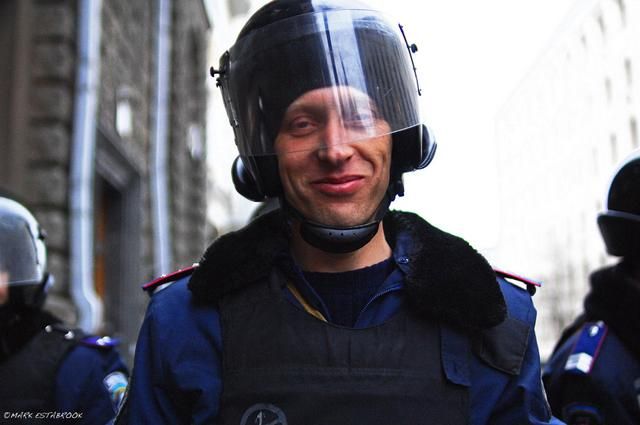
This process of shooting EuroMaidan fighters in their environment of soot covered barricade bags filled with ice began to change in just a short time. The temperatures were rising and the ice was melting. The bags that composed the barricades began to shrink and drain down the street. Much of the black soot turned into a charred mess that got on everything from your boots to your forehead, and all points in between. The smell of burnt tires and wood impregnated your clothing and your nostrils. I had that smell in my head for several weeks after I left Ukraine. They were just starting to replace the ice in the bags with sand as the Berkut invasion launched on February 18, 2014, one day prior to my departure.
I had seen on the news at my flat just blocks away from Grushevskogo Street that EuroMaidan fighters were burning tires again. This meant winds were favorable for such activity. There was nothing more beautiful in their Ukrainian sense of humor than burning tires upwind of the Berkut police. I knew I had to get downtown immediately.
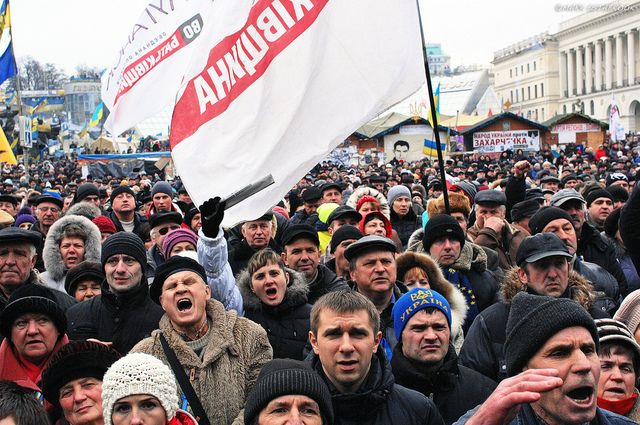
I threw on a bulletproof vest, helmet and gas mask and ran out the door. By the time I got to Grushevskogo Street, approximately a thousand citizens had arrived to watch what we all thought would be a dramatic round of street protests. The two sides had been engaged in negotiations for several weeks. One of the concessions made by the government was a release of several hundred protestors from jail in exchange for gates being installed in several of the barricades that blocked off downtown Kiev. This settlement was, of course, disingenuous at best. The government needed a thoroughfare through the barricades for their attacking force.
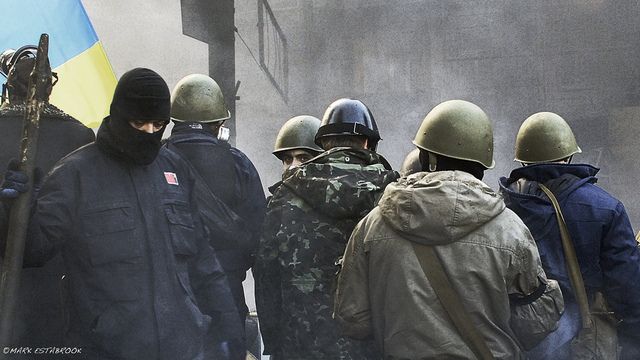
Upon my arrival at the barricade, I noticed a symbolic launching of Molotov cocktails. Sometimes the bottle would be lit prior to launch, and other times not. The EuroMaidan goal seemed to be to coat the street with gasoline in front of the Berkut police lines and then later ignite it with fireworks. This was not an easy proposition, as the Berkut kept several water cannons shooting thousands of gallons of water at the protestors and the street in front of the police lines. Much of the gasoline simply drained down the street and into the gutter. It was a very ineffective way to wage war. It was, in my opinion, a dramatic yet nonlethal way to express one’s displeasure with the government police. It didn’t seem to be hurting either side.
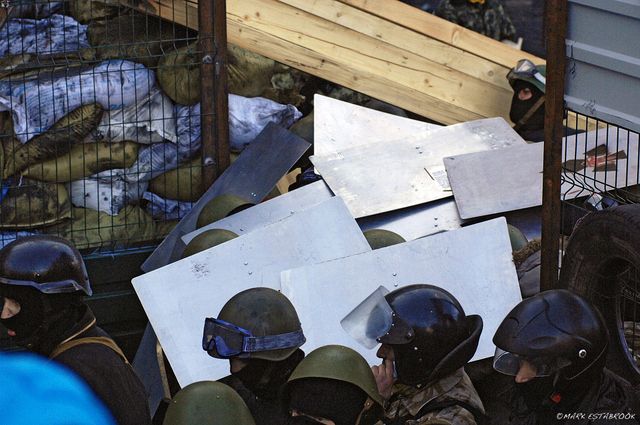
I got as close as I could to obtain shots of the battle, and then noticed a EuroMaidan commander inspecting the police buildup on their right flank. He watched them with binoculars for several minutes, and then simply turned around and walked away. As he retreated from the front, he rolled his eyes and inflated his cheeks with an expression of resignation. I sensed something significant was happening and was soon surprised to see the EuroMaidan forces begin a retreat from the DMZ as I called it. Included in these festivities was a trumpet performance of their national anthem, followed by blessings from Orthodox priests. Everyone but me seemed to know exactly what was about to happen.
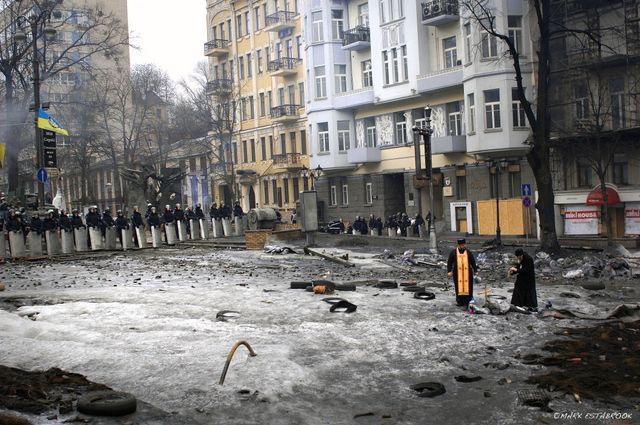
When the EuroMaidan forces were done with their religious blessings, an unmanned aerial vehicle (UAV) flew up Grushevskogo Street from the opposite direction and toward the barricade. It was a brilliant tactical move on the part of the Berkut. The EuroMaidan fighters turned away from the Berkut police and looked up at the UAV. They were jeering and shooting their middle index finger in defiance toward the airborne video camera. It was at this moment that I saw motion out of the corner of my eye. I was standing about 20 feet from the locked gate in the barricade, and turned to clearly see two Berkut policemen focused on the latch mechanism.
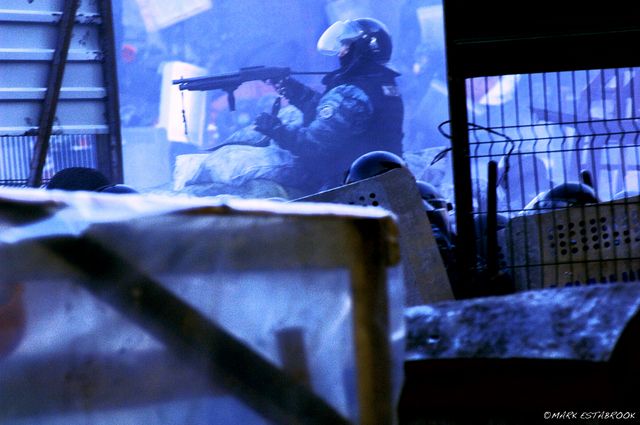
To me, it was a photo op and I took a snap. I turned to tell the closest EuroMaidan fighter they had company, but they were still focused on the UAV. When I turned back to the gate, there were 6 or 7 more Berkut policemen in place vigorously shaking the gate in an attempt to break the latch that prevented their incursion into EuroMaidan territory. Within seconds, the number of policemen grew by 100 or more. The gate latch broke and now they were pouring in.
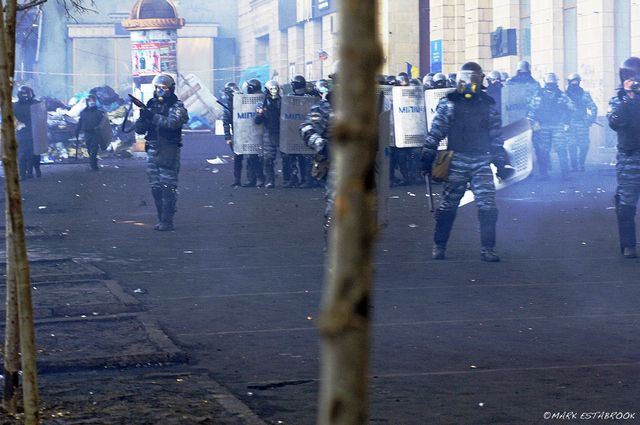
They did not hesitate to begin shooting. I kept snapping my camera, wondering how long it would be before my D2X would go into standby mode while it wrote the images to the memory card. I was more concerned about my older Nikon digital camera keeping up with events than I was about my personal safety. In other words, I was an idiot.
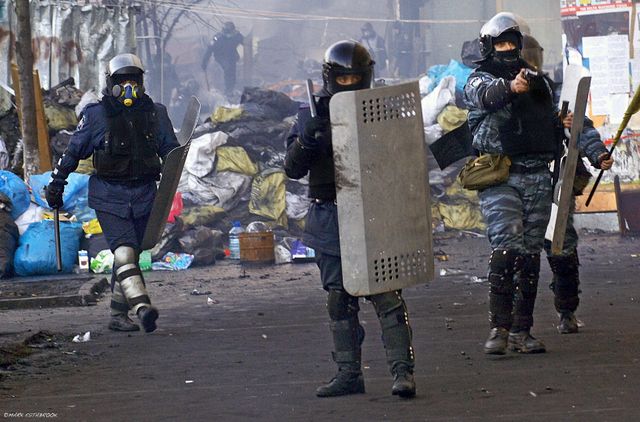
As I watched the Berkut make advances toward a secondary barricade, while throwing concussion grenades and firing their shotguns, pistols and automatic weapons, it soon occurred to me that I was behind enemy lines. This rather obvious fact turned into an attempt on my part to retreat, as had all of the other citizens, spectators and EuroMaidan fighters. Suddenly, two successive explosions occurred above my right shoulder and my lower left leg, followed by intense pain and ringing in my ears. I knew immediately grenades had hit me. My helmet and bulletproof vest prevented further injury to my skull or torso.
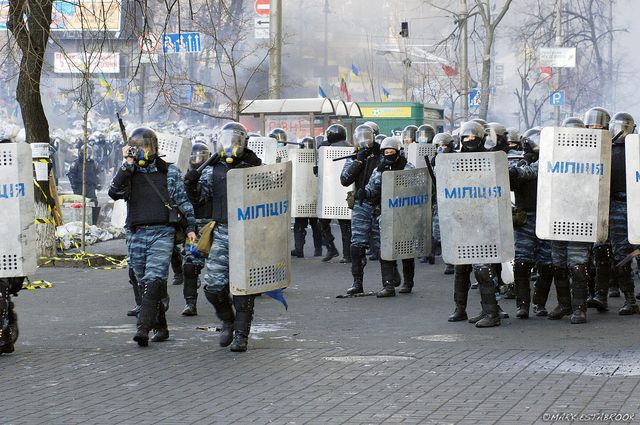
The explosion had loosened my helmet strap and I lost my sense of balance. I remember leaning forward slightly and my helmet fell to the street. I bent forward to pick it up, and just kept falling forward. A EuroMaidan fighter came from out of nowhere and assisted me. I remember him yelling at me but I couldn’t hear anything but the ringing in my ears. Once I got my helmet on, I started running for Maidan. My leg and shoulder were hurting, but the adrenaline rush I received from the “fight or flight” reaction dulled the pain to a more manageable level. I decided to turn around and run backwards while I snapped photos of the advancing Berkut police.
In this process of limping while running backwards and shooting more photos, I suddenly realized I was being video recorded by a police videographer. I had noticed it before in the days leading up to the invasion, and snapped photos of them surveilling me. It seemed odd at the time that this guy had such a fixation on me. The Berkut police were shooting into the retreating crowd. It seemed like a bad science fiction film. It was surrealistic to me. My eyes saw the action, but my brain could not process it. I began to rationalize what I was seeing in order to deny how much danger I was in. It was only later that I realized the significance of everything that had happened to all of us, including me.
Three or four unarmed EuroMaidan fighters began to taunt the Berkut police who were focused on attacking me. I was, in effect, the closest and slowest guy in front of the police. The EuroMaidan fighters, in essence, ran interference between the police line and me. They had no weapons, with the exception of a holstered club, but were taunting the police in an effort to keep their focus off of me and on them. The EuroMaidan fighters kept yelling at me but the ringing in my ears turned it into dull mush. Unless they spoke English to me, I would not have known what they said anyway. In retrospect, I am sure they were telling me to get my ass in gear and get out of there. There is no doubt their efforts saved my life.
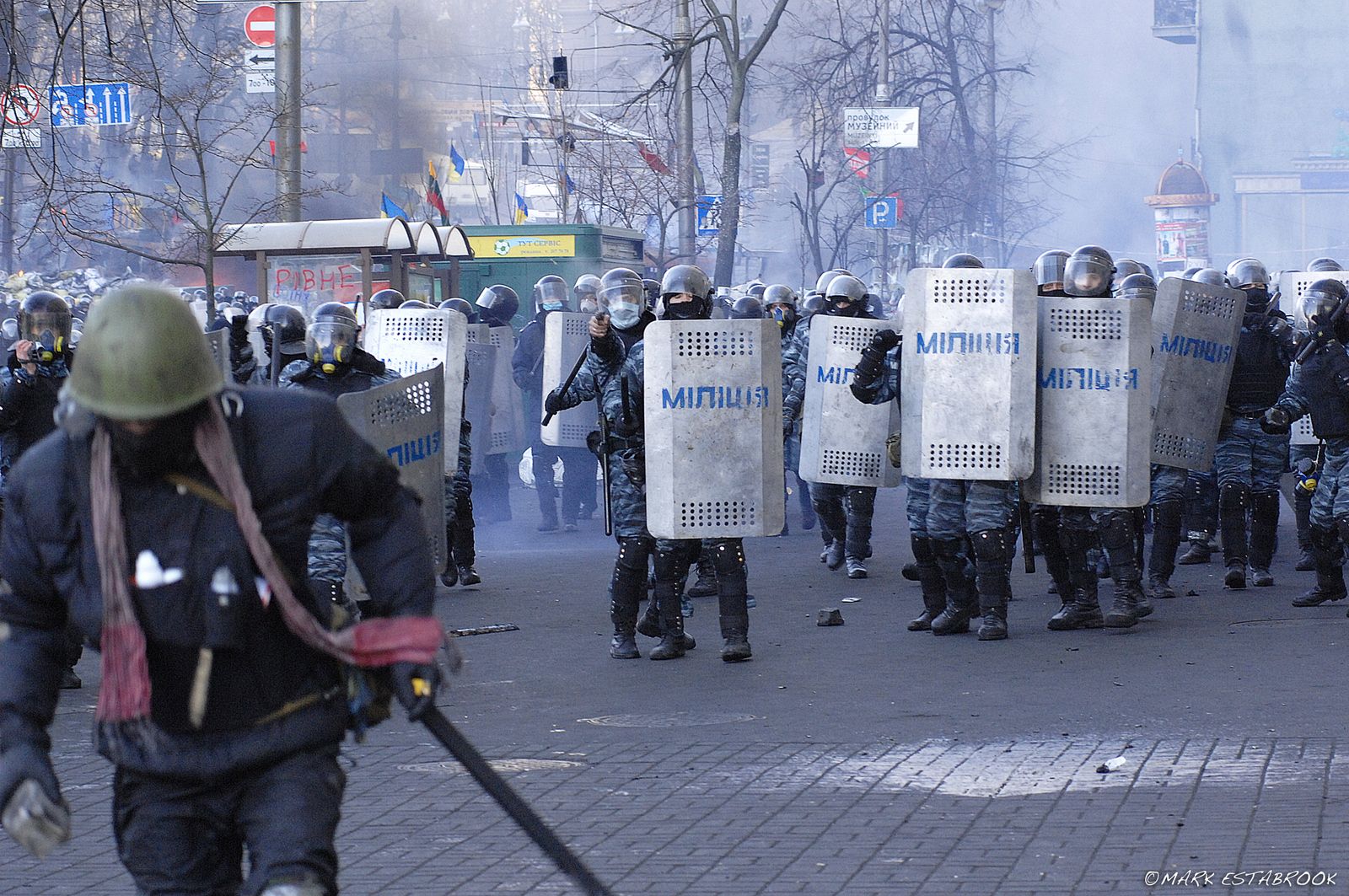 Click on image to enlarge to see close-up of weapon being fired
Click on image to enlarge to see close-up of weapon being fired
It was during one of their elliptical orbits around me that a Berkut policeman took aim at one of my protectors and shot him in the back. I am not just relying on my memory or recollection; this is from one of my photographs. You can see it frozen in time. Even the ejecting spent cartridge can be seen flying away from the semiautomatic gun.
The videographer is in frame, pointing his camera at the two of us. The protestor is starting to lean forward from the impact. In essence, he took a bullet for me while the police recorded the atrocity on video. I do not know his name, and I do not know if he survived. It is not easy to think about him, and as long as I live, I will never forget him. I do not know how to process it.
My safety was not secured yet. Another EuroMaidan fighter immediately replaced his fallen comrade. A Berkut policemen stepped forward with what would have been the third grenade intended for me. In the photo, you can see him staring straight at me. The EuroMaidan fighter distracted his attention, which gave me the opportunity to stow my camera and run. I was done shooting in Kiev, and figured it was time for me to devote more effort to saving my life.
I ran toward another barricade with an exit that led to Maidan proper. There were several hundred people already panicking to get through the same opening. The police were still shooting people in the back and throwing grenades. I joined the crowd, as I had no other choice. Within seconds, I felt the force of the crowd compressing my lungs. I could not breathe. It took every ounce of strength I had in my chest to force an inhalation. I heard the sound of dozens of people suffocating. It is not a pleasant sound. Suddenly, I realized a tall EuroMaidan fighter standing right next to me was holding a Molotov cocktail and lighter up in the air. I was trying to reach for the lighter and wanted to yell “No!” but all that I could muster was a whisper. He saw my outstretched hand trying to reach for his lighter. Slowly, he retracted his weapon. He had no chance of delivering the cocktail to his intended target, and the result would have been a conflagration of innocent people.
In what seemed like an eternity, I reached the opening in the barricade and was finally able to breathe. I did not even turn around to photograph the melee. Emotionally, I just could not do it. I am sure an experienced war photojournalist would have climbed the fence above the barricade and risked further injury from the Berkut in order to “get the shot”. I was just not that guy anymore. All I wanted to do was get back to my flat and look at photos.
Later that night I discovered I was bleeding from my shoulder and leg. I walked to the store to buy some whiskey, and ran into some ambulance attendants who dressed my wounds and tried to take me to the hospital. I declined their offer after having been advised that the police regularly visit the hospitals looking for the wounded, arrest them and take them away to beat and torture. I spent the rest of the night trying to report the story to the Austin American Statesman, before the Ukrainian government shut the Internet down. The cathedral in Maidan rang its church bells all night long as the sound of grenades rocked Kiev. The fighting continued for three days. Many people are missing and unaccounted for. I personally saw at least 20-30 people shot or injured from grenades during the initial attack at and retreat from the Grushevskogo Street barricade.
I talked to a friend the next morning, and was informed that the Berkut had sealed off the downtown area of Maidan and surrounding neighborhoods. They were looking for journalists and the wounded. I will be forever thankful that the Ukrainian people developed a strategy for smuggling me through police lines and getting me out of the downtown area and to the airport. It was ingenious and no, I am not telling you how they did it. Upon my arrival at the airline ticket counter, I was worried that blood was starting to seep through my shirt. The airlines do not allow wounded passengers on a commercial flight.
Once I had my boarding pass I went straight to the restroom to change my bandage again. I grabbed a thick stack of paper towels and stuffed some of them under my shirt. My wounds were already infected. I was very relieved when our landing gear was retracted and we were on our way to Europe. I jumped in a taxi when I arrived in Germany and went straight to the hospital where they removed three pieces of shrapnel during two and a half hours of surgery. My room was right across the street from a cathedral that rang its bells every hour. Every time they rang my heart raced back to Kiev and the sound of grenades.
It is taking me months to review, edit and publish my photos from that terrible day in Kiev. I think in some strange way the universe wanted me in Kiev for this Berkut attack. I don’t know why yet, but my gut tells me these photos are important in some small way. They may not be the most beautiful, or graphic, or the world’s best photojournalism, but I can tell you they are heartfelt and weren’t easy to come by. Perhaps they will make a contribution to the Ukrainian people’s quest for freedom.
© 2014 Mark Estabrook. All rights reserved.
About the author: Mark Estabrook is a commercial airline pilot and street photographer who began his photojournalism skills covering the music scene in Austin, Texas in the late 1970s. He holds a Bachelor of Science degree in Radio-TV-Film from the University of Texas at Austin, and a Masters Degree in Public Administration with an emphasis in policy analysis from the University of Oklahoma. He served as an AWACS Aircraft Commander in the Persian Gulf and in the North Atlantic during the 1980s. He is working on a book about his experience in Kiev, and hopes to complete it by the end of this year. He will be adding photos to his Kiev set at Flickr for the next few months.


